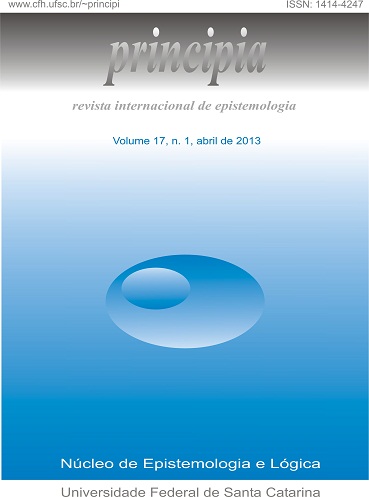Uma estrutura quase-conjuntista para a mecânica quântica não-relativista
DOI:
https://doi.org/10.5007/1808-1711.2013v17n1p103Resumo
Neste artigo são discutidas algumas questões acerca da natureza das partículas elementares tratadas pela mecânica quântica, em especial relacionadas aos conceitos de identidade e individualidade das mesmas. Iniciamos expondo brevemente as concepções filosóficas e formais acerca da identidade e individualidade, e, posteriormente, mostramos como essas noções são problemáticas quando aplicadas às partículas elementares como elétrons, prótons e nêutrons. Em particular, enfatizamos que tanto a filosofia, bem como a lógica e a teoria de conjuntos (e, assim, a matemática nessas últimas fundamentadas), partem do pressuposto usual que as coisas têm um ‘tipo’ de identidade e de individualidade (isto é, são indivíduos), no sentido de que objetos que tenham todas as mesmas propriedades são o mesmo objeto (são iguais). Não obstante, mostramos que no universo quântico é possível encontrar objetos que partilham de todas as suas propriedades, mas que não são apenas um, se constituindo tais objetos quânticos em algo como “não-indivíduos” (tese atualmente defendida por vários físicos e filósofos da ciência). Em seguida, mostramos como a matemática clássica — a qual, como dito, pressupõe uma individualidade para seus entes — se comporta perante esta situação; em particular admitindo pressupostos externos às teorias. Para se evitar tal procedimento, e assim buscar um formalismo mais ‘natural’ e adequado para se trabalhar com essas características, sugerimos o uso de uma teoria de conjuntos não-clássica chamada de teoria de quase-conjuntos, que baseada em uma lógica não-reflexiva, admite objetos desprovidos de identidade e individualidade ab initio. Por fim, mostramos uma outra aplicação para essa teoria, agora relacionada à busca por uma estrutura matemática quaseconjuntista que descreva o funcionamento da teoria quântica não-relativista, e discutimos algumas vantagens dessa estruturação perante uma baseada na teoria de conjuntos clássica.
Downloads
Publicado
Edição
Seção
Licença

A obra Principia de http://www.periodicos.ufsc.br/index.php/principia/index foi licenciada com uma Licença Creative Commons Atribuição-NãoComercial-SemDerivações 4.0 Internacional.
Com base na obra disponível em www.periodicos.ufsc.br.



